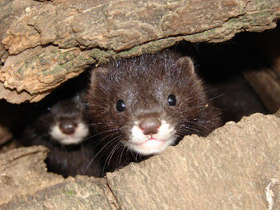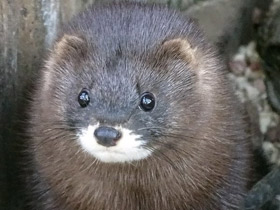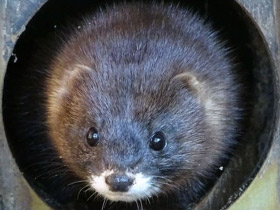The European mink or the Russian mink and Eurasian mink (Mustela lutreola)
The European mink (Mustela lutreola), also known as the Russian mink and Eurasian mink, is a semiaquatic species of mustelid native to Europe.
Appearance
Mustela lutreola is a critically endangered (CR) mustelid according to the IUCN classification.
In general appearance, Mustela lutreola is a typical representative of its genus and has a strongly elongated body slightly flattened from above and relatively short legs. The mink's head has a blunt muzzle and short, rounded ears, which barely protrude from the fur, also flattened from above. The toes of Mustela lutreola are connected by swimming webs, and these webs are more developed on the hind legs, reaching to the third phalanx of the toes. The tail of Mustela lutreola, evenly covered with short, closely attached hairs, is one-third the length of its body. The body length of Mustela lutreola ranges from 32 to 44 cm, and the tail from 12.4 to 20 cm. Males differ from females in their larger size.
The winter coat of Mustela lutreola is very thick and dense, although it is short and rather loose. Compared to terrestrial species of the genus, the undercoat is particularly dense. The hairs are quite thick and glossy and, as in all "amphibious" mammals, the hairs covering them have a very broad flattened mid-section. There is relatively little difference in the length and density of the coat on different parts of the body, especially on the back and belly. These and other characteristics of Mustela lutreola's coat are related to its semi-aquatic lifestyle. The summer coat is somewhat shorter, thicker and less dense than the winter coat, but the difference is negligible and incomparably less than that of all other purely terrestrial species in the genus.
Habitat
Mustela lutreola's life is closely related to freshwater, so it makes its home on the banks of streams, rivers and lakes, rarely moving more than 200 m from the water body. Favourite habitats of Mustela lutreola are the eroded shrub and woodland banks of small rivers and streams, as well as oxbows and small lakes. Mustela lutreola avoids large open rivers with sandy banks. Mustela lutreola sometimes settles near mills, unafraid of human presence and activities. In the steppe zone, it lives on floodplains and among the reed thickets of large rivers.
In summer, Mustela lutreola usually stays in one place and lives for a long time in a small area. Here, under a washed-out overhanging bank, in roots or in piles of sediment and debris, it makes its nest and spends the day. When food is plentiful, it gathers provisions in its burrows, dragging fish, urchins, frogs and small captured animals. Often, after finding a whisk set by fishermen, the Mustela lutreola will drag a large quantity of netted fish towards itself.
Reproduction
Mustela lutreola is active all year round. The flow in the middle belt of the USSR takes place at the end of March and in April, simultaneously with the opening and flooding of the rivers. Several males chase one female and sometimes fight each other. The young (4 to 7 individuals) appear in mid-May or even mid-June. They are born blind, naked and defenceless, but they grow rapidly and at 8-10 weeks they go hunting with the mother, and at 10-12 weeks they begin an independent life.
Nutrition and lifestyle
The main food of Mustela lutreola is small fish: gobies, minnows, wolffish, young wolffish, which it chases underwater and in the roots of creeping trees. In addition, Mustela lutreola catches small rodents, especially water rats, as well as frogs, hedgehogs, crayfish and molluscs; sometimes it attacks birds. It hunts mainly at dusk and at night, but can also be seen during the day. Spends most of its time on the shore, running among roots and under overhanging bank. During the chase, it dives and swims 10-20 m underwater, after which it emerges at the surface, quickly gathers fresh air and dives again. Mustela lutreola swims well, keeping a considerable part of its body out of the water, but climbs trees poorly. The most dangerous enemy of Mustela lutreola is the otter.
Evolution and taxonomy
Fossil finds of the European mink are very scarce, indicating that the species is relatively new to Europe, probably originating in North America, or a recent speciation caused by hybridisation. It probably first appeared in the Middle Pleistocene, with several fossils in Europe dating to the Late Pleistocene found in caves and some suggesting early exploitation by humans. Genetic analysis indicates that, rather than being closely related to the American mink, the closest relative of the European mink is the European polecat (perhaps due to past hybridisations) and the Siberian weasel, being intermediate in form between true polecats and other members of the genus. The proximity between mink and polecat is accentuated by the fact that the species can hybridise.
Predators
Predators of the European mink include the European polecat, American mink, golden eagle, great horned owls and red fox. Red fox numbers have greatly increased in areas where the wolf and Eurasian lynx have been extirpated, as well as in areas where modern forestry is practised. As red foxes are known to prey on mustelids, excessive predation of European mink by foxes is a possible factor, although it is unlikely to have been a factor in Finland, where fox numbers were low in the early 20th century.
Subspecies
- Mustela lutreola biedermanni;
- Mustela lutreola binominata;
- Mustela lutreola cylipena;
- Mustela lutreola lutreola lutreola;
- Mustela lutreola novikovi;
- Mustela lutreola transsylvanica;
- Mustela lutreola turovi.



















































